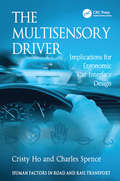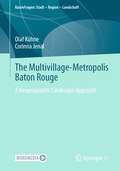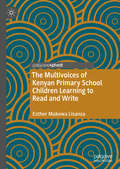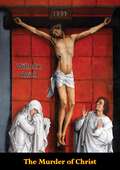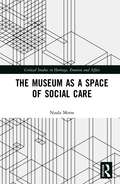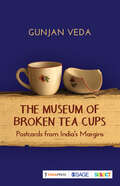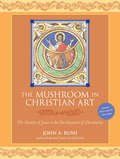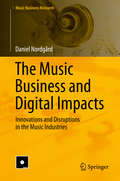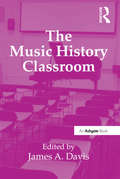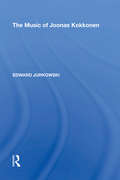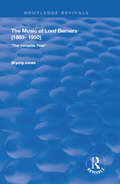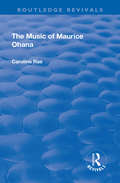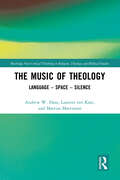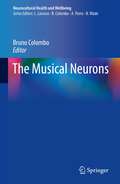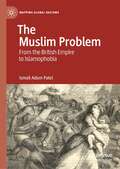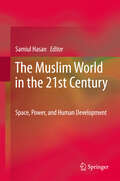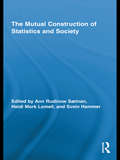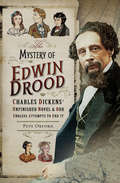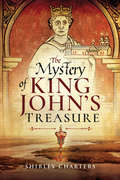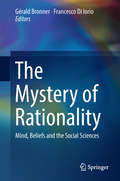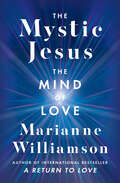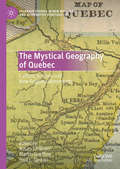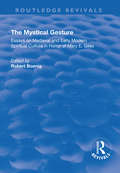- Table View
- List View
The Multisensory Driver: Implications for Ergonomic Car Interface Design (Human Factors in Road and Rail Transport)
by Charles Spence Cristy HoDriver inattention has been identified as one of the leading causes for car accidents. The problem of distraction while driving is likely to worsen, partly due to increasingly complex in-car technologies. However, intelligent transport systems are being developed to assist drivers and to ensure a safe road environment. One approach to the design of ergonomic automobile systems is to integrate our understanding of the human information processing systems into the design process. This book aims to further the design of ergonomic multisensory interfaces using research from the fast-growing field of cognitive neuroscience. It focuses on two aspects of driver information-processing in particular: multisensory interactions and the spatial distribution of attention in driving. The Multisensory Driver provides interface design guidelines together with a detailed review of current cognitive neuroscience and behavioural research in multisensory human perception, which will help the development of ergonomic interfaces. The discussion on spatial attention is particularly relevant for car interface designers, but it will also appeal to cognitive psychologists interested in spatial attention and the applications of these theoretical research findings. Giving a detailed description of a cohesive series of psychophysical experiments on multisensory warning signals, conducted in both laboratory and simulator settings, this book provides an approach for those in the engineering discipline who wish to test their systems with human observers.
The Multivillage-Metropolis Baton Rouge: A Neopragmatic Landscape Approach (RaumFragen: Stadt – Region – Landschaft)
by Olaf Kühne Corinna JenalThe capital of Louisiana, Baton Rouge, has been the scene of fundamental changes in recent decades. In the context of the tripole of petrochemistry, Louisiana State University (LSU) and public administration (especially of the state of Louisiana), which has been fully developed since the end of the 1920s, general processes (such as the transition from modern to post-modern spatial development) mix with specific local and regional characteristics and logics, also in dealing with spaces (such as the eccentric location of the downtown area, the limited influence of spatial planning). The result is a social-spatial formation of a 'multivillage metropolis'. The investigation of this 'multivillage metropolis' follows a neopragmatic approach that triangulates different theories, methods, data and researcher perspectives.Videos per App: Laden Sie die Springer Nature More Media kostenlos herunter - Abbildungen im Buch per App mit Handy oder Tablet scannen, um Videos zu streamen.
The Multivoices of Kenyan Primary School Children Learning to Read and Write
by Esther Mukewa LisanzaThis book provides a rich and nuanced examination of children learning to read and write a second language in primary schools in Kenya, taught by teachers who themselves have often learned English as a second or third language. The author uses two case studies, of an urban and a rural school, to explore how different socioeconomic and cultural contexts can affect the enactment of language policies and their effect on literacy. This book contributes a unique perspective to studies in language and literacy education due to its distinctive exploration of young children learning to read and write in the English language in Kenya, and it will be of particular interest to students and scholars of applied linguistics, language education, bilingualism and language policy.
The Mural at the Waverly Inn: A Portrait of Greenwich Village Bohemians
by Dorothy Gallagher Edward SorelSorel--whose caricatures and drawings regularly appear in The New Yorker and on its cover--chose forty Greenwich Village greats from the past 150 years to cavort in bacchanalian splendor. Each of the 40 makes a solo appearance in these pages alongside a charming, telling vignette of his or her life by Dorothy Gallagher, then appears in a foldout of the entire mural at the back of the book.
The Murder of Christ
by Wilhelm ReichIn this profound and moving work, the scientist Wilhelm Reich explores the meaning of Christ's life and reveals the hidden, universal scourge that caused his agonizing death--The Emotional Plague of Mankind. Reich contends that man is faced with full responsibility for the murder of Christ all through the ages--for the murder of fellow human beings, no matter what the circumstances. Here is the blunt truth about people's true ways of being, acting and emotional reacting. Here, also, the lesson of the murder of Christ is applied to the contemporary social scene. The tragedy of Reich's own death points up the fact that the problems presented in THE MURDER OF CHRIST are acute problems of present-day society.-Print ed.
The Museum as a Space of Social Care (Critical Studies in Heritage, Emotion and Affect)
by Nuala MorseThis book examines the practice of community engagement in museums through the notion of care. It focuses on building an understanding of the logic of care that underpins this practice, with a view to outlining new roles for museums within community health and social care. This book engages with the recent growing focus on community participation in museum activities, notably in the area of health and wellbeing. It explores this theme through an analysis of the practices of community engagement workers at Tyne & Wear Archives & Museums in the UK. It examines how this work is operationalised and valued in the museum, and the institutional barriers to this practice. It presents the practices of care that shape community-led exhibitions, and community engagement projects involving health and social care partners and their clients. Drawing on the ethics of care and geographies of care literatures, this text provides readers with novel perspectives for transforming the museum into a space of social care. This book will appeal to museum studies scholars and professionals, geographers, organisational studies scholars, as well as students interested in the social role of museums.
The Museum of Broken Tea Cups: Postcards from India’s Margins
by Gunjan VedaThe performing arts in India have traditionally been the domain of Dalit communities. To this day, these men and women continue to nurture and foster their chosen art forms in the face of discrimination and prejudice. We consider ourselves to be connoisseurs of art and culture. Yet, we fail to recognize the very communities who have shaped this culture. The Museum of Broken Tea Cups, using the symbology of the used, broken tea cup that upper caste households leave outside their doors for the use of Dalit workers, is an effort to recognize the immense cultural contribution made by Dalit communities through the stories of individual artists who languish in the forgotten gallis and mohallas of our villages and towns. At the same time, the book seeks to celebrate the everyday heroes, who have, despite all odds, managed to change not just their own lives, but the lives of those around them. These are students and teachers, artists and activists, storytellers and devadasis, daughters and mothers, sons and brothers—seemingly ordinary people—whose faces get lost in everyday life, but whose stories have the potential to inspire admiration, action and change.
The Mushroom in Christian Art: The Identity of Jesus in the Development of Christianity
by John Rush Martin W. BallIn The Mushroom in Christian Art, author John A. Rush uses an artistic motif to define the nature of Christian art, establish the identity of Jesus, and expose the motive for his murder. Covering Christian art from 200 CE (common era) to the present, the author reveals that Jesus, the Teacher of Righteousness mentioned in the Dead Sea Scrolls, is a personification of the Holy Mushroom, Amanita muscaria. The mushroom, Rush argues, symbolizes numerous mind-altering substances—psychoactive mushrooms, cannabis, henbane, and mandrake—used by the early, more experimentally minded Christian sects.Drawing on primary historical sources, Rush traces the history—and face—of Jesus as being constructed and codified only after 325 CE. The author relates Jesus’s life to a mushroom typology, discovering its presence, disguised, in early Christian art. In the process, he reveals the ritual nature of the original Christian cults, rites, and rituals, including mushroom use. The book authoritatively uncovers Jesus’s message of peace, love, and spiritual growth and proposes his murder as a conspiracy by powerful reactionary forces who would replace that message with the oppressive religious-political system that endures to this day. Rush’s use of the mushroom motif as a springboard for challenging mainstream views of Western religious history is both provocative and persuasive.The package includes an informative DVD with 252 striking color images depicting Christian art, with key motifs indicated by the author.
The Music Business and Digital Impacts: Innovations and Disruptions in the Music Industries (Music Business Research)
by Daniel NordgårdThis book provides rare insights into the difficult and complex dialogues between stakeholders within and outside the music industries in a time of transition. It builds on a series of recorded meetings in which key stakeholders discuss and assess options and considerations for the music industries’ transition to a digital era. These talks were closed to the public and operated under the Chatham House Rule, which means that they involved a very different type of discussion from those held in public settings, panels or conferences. As such, the book offers a much more nuanced understanding of the industries’ difficulties in adjusting to changing conditions, demonstrating the internal power-struggles and differences that make digital change so difficult. After presenting a theoretical framework for assessing digital change in the music industries, the author then provides his research findings, including quotes from the Kristiansand Roundtable Conference. Following from these findings, he develops three critical concepts that explain the nature as well as the problems of the music industries’ adaptation process. In conclusion, he challenges the general definition of crisis in the music industries and contradicts the widely held view that digitalization is a case of vertical integration.
The Music History Classroom
by James A. DavisThe Music History Classroom brings together essays written by recognized and experienced teachers to assist in the design, implementation, and revision of college-level music history courses. This includes the traditional music history survey for music majors, but the materials presented here are applicable to other music history courses for music majors and general education students alike, including period classes, composer or repertory courses, and special topics classes and seminars. The authors bring current thought on the scholarship of teaching and learning together with practical experience into the unique environment of the music history classroom. While many of the issues confronting teachers in other disciplines are pertinent to music history classes, this collection addresses the unique nature of musical materials and the challenges involved in negotiating between historical information, complex technical musical issues, and the aesthetics of performing and listening. This single volume provides a systematic outline of practical teaching advice on all facets of music history pedagogy, including course design, classroom technology, listening and writing assignments, and more. The Music History Classroom presents the 'nuts-and-bolts' of teaching music history suitable for graduate students, junior faculty, and seasoned teachers alike.
The Music of Joonas Kokkonen
by Edward JurkowskiJoonas Kokkonen (1921-1996) has been one of the most performed Finnish composers during the past 25 years both within Finland and abroad.The author's study of Joonas Kokkonen is the first full-scale account in English. Starting with a brief survey of Finnish music during the 20th century, the book then devotes a separate chapter to each of the major genres in which Kokkonen composed: symphonic, orchestral, vocal, chamber and keyboard. Illustrated with over a hundred music examples, The Music of Joonas Kokkonen seeks to overturn his reputation in some quarters as a conservative, even old fashioned, composer, and argues that Kokkonen created an interesting and refreshing approach to dodecaphonic composition and pitch organization. With a full chronological listing of works and bibliography, this book is the most important reference source to date on Kokkonen and his music." "Book Description: One of the most performed Finnish composers during the last 25 years, Joonas Kokkonen (1921-1996) was also instrumental in the development of the nation's system of music education. In this study,the author (music, U. of Lethbridge, Canada) examines Kokkonen's compositions in each of five major genres: symphonic, orchestral, vocal, chamber, and key
The Music of Lord Berners (1883-1950): The Versatile Peer
by Bryony JonesThis title was first published in 2003. Gerald Tyrwhitt-Wilson, the 14th Baron Berners, was a well-known figure in his day. Labelled by the national press as "the versatile peer", he was a composer, writer, painter and great socialite. His musical output was small, but highly successful in its day, with ballets staged in London, Monte Carlo and New York, an opera produced in Paris, and two film scores completed in the 1940s. These works, together with Berners' songs, his music for piano, and other instrumental pieces are given their first in-depth examination in this study. Bryony Jones shows how Berners' cosmopolitan musical style radically differed from that of many of his contemporaries who were concerned with creating a "national" music. Instead, Berners drew his inspiration from abroad, and comparisons are drawn with Les Six, and connections made with the work of Satie, Debussy and Ravel. Well-known for his elaborate practical jokes and sense of humour, Berners was an archetype of British eccentricity, and these aspects of his personality shaped much of his musical style. The book concludes with an attempt to explain why Berners' music was neglected following his death, and why there has been a recent resurgence of interest.
The Music of Maurice Ohana (Routledge Revivals)
by Caroline RaeThis title was first published in 2000. Pianist and scholar Rae presents a detailed study of composer Maurice Ohana's life and music, and identifies the procedures that characterize his mature style. In the initial chapters, she provides a biographical overview and sets his work in its musical and cultural context.
The Music of Theology: Language – Space – Silence (Routledge New Critical Thinking in Religion, Theology and Biblical Studies)
by Andrew Hass Mattias Martinson Laurens ten KateThis book reconceives theology as a musical endeavour in critical tension with language, space and silence. An Overture first moves us from music to religion, and then from theology back to music – a circularity that, drawing upon history, sociology, phenomenology, and philosophy, disclaims any theology of music and instead pursues the music in theology. The chapters that follow explore the three central themes by way of theory, music and myth: Adorno, Benjamin and Deleuze (language), Derrida, Rosa and Nancy (space), Schelling/Hegel, Homer and Cage (silence). In overdubbing each other, these chapters work towards theology as a sonorous rhythm between loss and freedom. A Coda provides three brief musical examples – Thomas Tallis, György Ligeti, and Evan Parker – as manifestations of this rhythm, to show in summary how music becomes the very pulse of theology, and theology the very intuition of music. The authors offer an interdisciplinary engagement addressing fundamental questions of the self and the other, of humanity and the divine, in a deconstruction of modern culture and of its bias towards the eye over the ear. The book harmonizes three scholarly voices who attempt to find where the resonance of our Western conceptions and practice, musically and theologically, might resound anew as a more expansive music of theology.
The Musical Neurons (Neurocultural Health and Wellbeing)
by Bruno ColomboThis book explores connections between music, neural activations and brain plasticity, in order to better understand its associated psychological and physiological effects. The final goal is to focus on the positive effects of music to treat neurological disorders, establishing a new co-ordination between different brain areas to improve both mental illness and wellbeing. A secondary goal is to analyse the role of music at a psycho-sociological level, to understand both the transformation of music into a cultural model and the vision of music as an innate instinct.Music is able to create both emotions and volitional processes. The application of new neuroimaging techniques allows us to explore and evaluate with accuracy what happens in our brain during the creative and artistic performance. A wide range of brain regions are recruited for creative tasks, and music has the opportunity to help in enhance and reset some brain pathological disturbances being also able to ameliorate and restore some rhythmic body activities such as sleep, movement and co-ordination. The book represents a valuable and innovative tool both for neurologists as well as healthcare professionals involved in the management of neurological disorders.
The Muslim Problem: From the British Empire to Islamophobia (Mapping Global Racisms)
by Ismail Adam PatelThis book explains the increasing incidences and normalisation of Islamophobia, by analysing the role of signifiers of free speech, censorship, and fatwa during the Satanic Verses affair in problematising the figure of the Muslim. Ismail Patel develops the notion of Islamophobia not as a continuation of the antagonistic relation from the British Empire but as a postcolonial reformulation of the figure of the Muslim. The book views Islamophobia studies as a paradigm, engages in the debate of Islamophobia as a global phenomenon, investigates the contestation over its definition and challenges the view of Islamophobia as a reserve of the far-right. It assesses the debate around the concept of identity and shows how the colonised figure of the Muslim provided significance in constructing British imperial identity. Providing a decolonial, counter-Islamophobia approach that challenges Britishness’ exclusionary white symbolic content, the book calls for a liberating idea of Britishness that promotes a post-racist rather than a post-race society. Theoretically rich in analysis, this book will contribute to discussions of identity formation, Britishness, Islamophobia and counter-Islamophobia. It will be of use to students and researchers across history, politics, sociology, cultural studies, literary studies, and anthropology.
The Muslim World in the 21st Century
by Samiul HasanIslam is not only a religion, but also a culture, tradition, and civilization. There are currently 1.5 billion people in the world who identify themselves as Muslim. Two thirds of the worldwide Muslim population, i.e. approximately a billion people, live in forty-eight Muslim majority countries (MMC) in the world- all of which except one are in Africa and Asia. Of these MMCs in Africa and Asia, only twelve (inhabited by about 165 million people) have ever achieved a high score on the Human Development Index (HDI), the index that measures life expectancy at birth, education and standard of living and ranks how "developed" a country is. This means that the majority of the world's Muslim population lives in poverty with low or medium level of human development. The contributions to this innovative volume attempt to determine why this is. They explore the influence of environment, space, and power on human development. The result is a complex, interdisciplinary study of all MMCs in Africa and Asia. It offers new insights into the current state of the Muslim World, and provides a theoretical framework for studying human development from an interdisciplinary social, cultural, economic, environmental, political, and religious perspective, which will be applicable to regional and cultural studies of space and power in other regions of the world.
The Mutual Construction of Statistics and Society (Routledge Advances in Research Methods)
by Ann Rudinow SætnanStatistics are often seen as simple, straightforward, and objective descriptions of society. However, what we choose to count, what we choose not to count, who does the counting, and the categories and values we choose to apply when counting, matter. This volume addresses the ways in which statistics and numbers are gathered and applied in social science research. The contributors argue that we must become more aware of the power and the limitations of statistics. Learning statistics needs to be about more than simply mastering the techniques of using the tool; it needs to also be about learning the dangers of that tool and learning to control it within social and ethical bounds. These dangers lie in the routines through which statistics are applied; the discourses from which they emerge and into which they are deployed; the power relations created by those discourses; and the assumptions, meanings, and categories statistics carry with them in those discourses. This volume will be necessary reading for students and scholars using quantitative data within the social sciences.
The Mystery of Courage
by William Ian MillerFew of us spend much time thinking about courage, but we know it when we see it--or do we? Is it best displayed by marching into danger, making the charge, or by resisting, enduring without complaint? Is it physical or moral, or both? Is it fearless, or does it involve subduing fear? Abner Small, a Civil War soldier, was puzzled by what he called the "mystery of bravery"; to him, courage and cowardice seemed strangely divorced from character and will. It is this mystery, just as puzzling in our day, that William Ian Miller unravels in this engrossing meditation. Miller culls sources as varied as soldiers' memoirs, heroic and romantic literature, and philosophical discussions to get to the heart of courage--and to expose its role in generating the central anxieties of masculinity and manhood. He probes the link between courage and fear, and explores the connection between bravery and seemingly related states: rashness, stubbornness, madness, cruelty, fury; pride and fear of disgrace; and the authority and experience that minimize fear. By turns witty and moving, inquisitive and critical, his inquiry takes us from ancient Greece to medieval Europe, to the American Civil War, to the Great War and Vietnam, with sidetrips to the schoolyard, the bedroom, and the restaurant. Whether consulting Aristotle or private soldiers, Miller elicits consistently compelling insights into a condition as endlessly interesting as it is elusive.
The Mystery of Edwin Drood: Charles Dickens' Unfinished Novel and Our Endless Attempts to End It
by Pete OrfordA tantalizing tour through a true bibliomystery that will “get people talking about one of literature’s greatest enigmas” (KentOnline). When Dickens died on June 9, 1870, he was halfway through writing his last book, The Mystery of Edwin Drood. Since that time, hundreds of academics, fans, authors, and playwrights have presented their own conclusion to this literary puzzler. Step into 150 years of Dickensian speculation to see how our attitudes both to Dickens and his mystifying last work have developed. At first, enterprising authors tried to cash in on an opportunity to finish Dickens’ book. Dogged attempts of early twentieth-century detectives proved Drood to be the greatest mystery of all time. Earnest academics of the mid-century reinvented Dickens as a modernist writer. Today, the glorious irreverence of modern bibliophiles reveals just how far people will go in their quest to find an ending worthy of Dickens. Whether you are a die-hard Drood fan or new to the controversy, Dickens scholar Pete Orford guides readers through the tangled web of theories and counter-theories surrounding this great literary riddle. From novels to websites; musicals to public trials; and academic tomes to erotic fiction, one thing is certain: there is no end to the inventiveness with which we redefine Dickens’ final story, and its enduring mystery.
The Mystery of King John's Treasure
by Shirley ChartersSunday evening, October 9th, 1216. King John is facing continued civil war and a devastating French invasion; treacherous times. We discover him crossing the tidal marshes of the Fenlands of East Anglia. He is about to lose Englands crown jewels, his gem collection, and sackfuls of silver coins with his image on them: a treasure trove.What happened? What was he doing in that remote and windswept place? Why did he take the crown jewels with him? And why did he die so soon afterwards?Eight hundred years of searches by Fenfolk, academics, newspaper magnates, Victorian eccentrics and even an American research company have found nothing. No golden chalice, no pearl studied casket, no coins. Why?We follow King John at that vulnerable time, day by day, and reveal for the first time some surprising and interesting answers to the many questions posed by the mystery of his lost treasure.
The Mystery of Rationality: Mind, Beliefs and the Social Sciences (Lecture Notes in Morphogenesis)
by Gérald Bronner Francesco Di IorioThis book contributes to the developing dialogue between cognitive science and social sciences. It focuses on a central issue in both fields, i.e. the nature and the limitations of the rationality of beliefs and action. The development of cognitive science is one of the most important and fascinating intellectual advances of recent decades, and social scientists are paying increasing attention to the findings of this new branch of science that forces us to consider many classical issues related to epistemology and philosophy of action in a new light. Analysis of the concept of rationality is a leitmotiv in the history of the social sciences and has involved endless disputes. Since it is difficult to give a precise definition of this concept, and there is a lack of agreement about its meaning, it is possible to say that there is a ‘mystery of rationality’. What is it to be rational? Is rationality merely instrumental or does it also involve the endorsement of values, i.e. the choice of goals? Should we consider rationality to be a normative principle or a descriptive one? Can rationality be only Cartesian or can it also be argumentative? Is rationality a conscious skill or a partly tacit one? This book, which has been written by an outstanding collection of authors, including both philosophers and social scientists, tries to make a useful contribution to the debates on these problems and shed some light on the mystery of rationality. The target audience primarily comprises researchers and experts in the field.
The Mystic Jesus: The Mind of Love (The Marianne Williamson Series)
by Marianne WilliamsonReturning to the topic of her beloved classic bestseller A Return to Love, spiritual guide Marianne Williamson builds on the ideas introduced in that book to lead us toward the light through the inspiring guidance of the mystic Jesus.In A Return to Love: Reflections on the Principles of A Course in Miracles, Marianne Williamson revealed how we each become miracle-workers when expressing love and forgiveness in our everyday lives. With The Mystic Jesus, Williamson reveals the role of Jesus in the teachings of the Course. For many, Jesus has become a precious relic, revered yet lacking the immediacy of authentic spiritual force. In The Mystic Jesus, Williamson writes of a Jesus who transcends both glib imagery and outdated religious dogma. She writes not only of an historical Messiah but of a spirit alive in all of us today.Williamson brings to The Mystic Jesus her talent at making the densest theological theories relevant to our everyday lives. She merges psychological and religious understanding, presenting Jesus as a guide to another way of thinking, therefore the builder of another kind of world. The Jesus in The Mystic Jesus truly is, in the words of St. Augustine, “ever ancient, ever new.”The Jesus presented here is a radical love, an ever-present teacher, an evolutionary elder brother, and a savior from the fear-based, twisted thinking that dominates our world. The Mystic Jesus is both theological and practical, signature Williamson in both its intellectual clarity and emotional impact.
The Mystical Geography of Quebec: Catholic Schisms and New Religious Movements (Palgrave Studies in New Religions and Alternative Spiritualities)
by Paul L. Gareau Susan J. Palmer Martin GeoffroyThis study of new religious movements in Quebec focuses on nine groups—including the notoriously violent Solar Temple; the iconoclastic Temple of Priapus; and the various “Catholic” schisms, such as those led by a mystical pope; the Holy Spirit incarnate; or the reappearance of the Virgin Mary. Eleven contributing authors offer rich ethnographies and sociological insights on new spiritual groups that highlight the quintessential features of Quebec's new religions (“sectes” in the francophone media). The editors argue that Quebec provides a favorable “ecology” for alternative spirituality, and explore the influences behind this situation: the rapid decline of the Catholic Church after Vatican Il; the “Quiet Revolution,” a utopian faith in Science; the 1975 Charter of Human Rights and Freedoms; and an open immigration that welcomes diverse faiths. The themes of Quebec nationalism found in prophetic writings that fuel apocalyptic ferment are explored by the editors who find in these sectarian communities echoes of Quebec’s larger Sovereignty movement.
The Mystical Gesture: Essays on Medieval and Early Modern Spiritual Culture in Honor of Mary E.Giles
by Robert BoenigThis title was first published in 2000: These essays ecplore the spiritual culture shared by texts and writers in Western Europe from the 13th to 17th centuries; the visionaries, mystics and nuns who were poets or scholars and the creative writers who drew on spiritual themes. The topics range chronologically from the late 13th to late 17th centuries and geographically from Germany, England, Italy, France, Spain and New Spain (Mexico), though the volume's centre is the spiritual culture of 16th-century Spain. Common concerns of each essay are the exploration of spiritual culture; how some texts and writers shape expectations attending the life of the spirit; and how they are in turn shaped by them. The sub-themes many of the essays share are the gendering of spiritual culture and the relationship between traditional literary genres like poetry and drama and spiritual discourse. Each text or spiritual figure covered here has a distinctive spiritual voice - a mystical gesture - that contributes an individual mysticism to the common spiritual culture they all share. Each scholar in her or his own way defines this mystical gesture. The essays analyze Mechthild von Magdburg, "Piers Plowman", "The Second Shepherds' Play", Catherine of Siena, Bernardo de Laredo, Teresa of Avila, Alonso de la Fuente, Luisa de Carvajal y Mendoza, Cecilian de nacimiento, Margaret Mary Alaconque and Sor Juana.
